How Do Yec's Explain Ice Core Readings
Introduction
Glaciers form as layers of snow accumulate on top of each other. Each layer of snow is different in chemistry and texture, summer snowfall differing from wintertime snow. Over fourth dimension, the buried snow compresses under the weight of the snow to a higher place it, forming water ice. Particulates and dissolved chemicals that were captured by the falling snow go a part of the ice, as do bubbles of trapped air. Layers of ice accrue over seasons and years, creating a record of the climate conditions at the time of germination, including snow accumulation, local temperature, the chemical limerick of the atmosphere including greenhouse gas concentrations, volcanic activeness, and solar action.
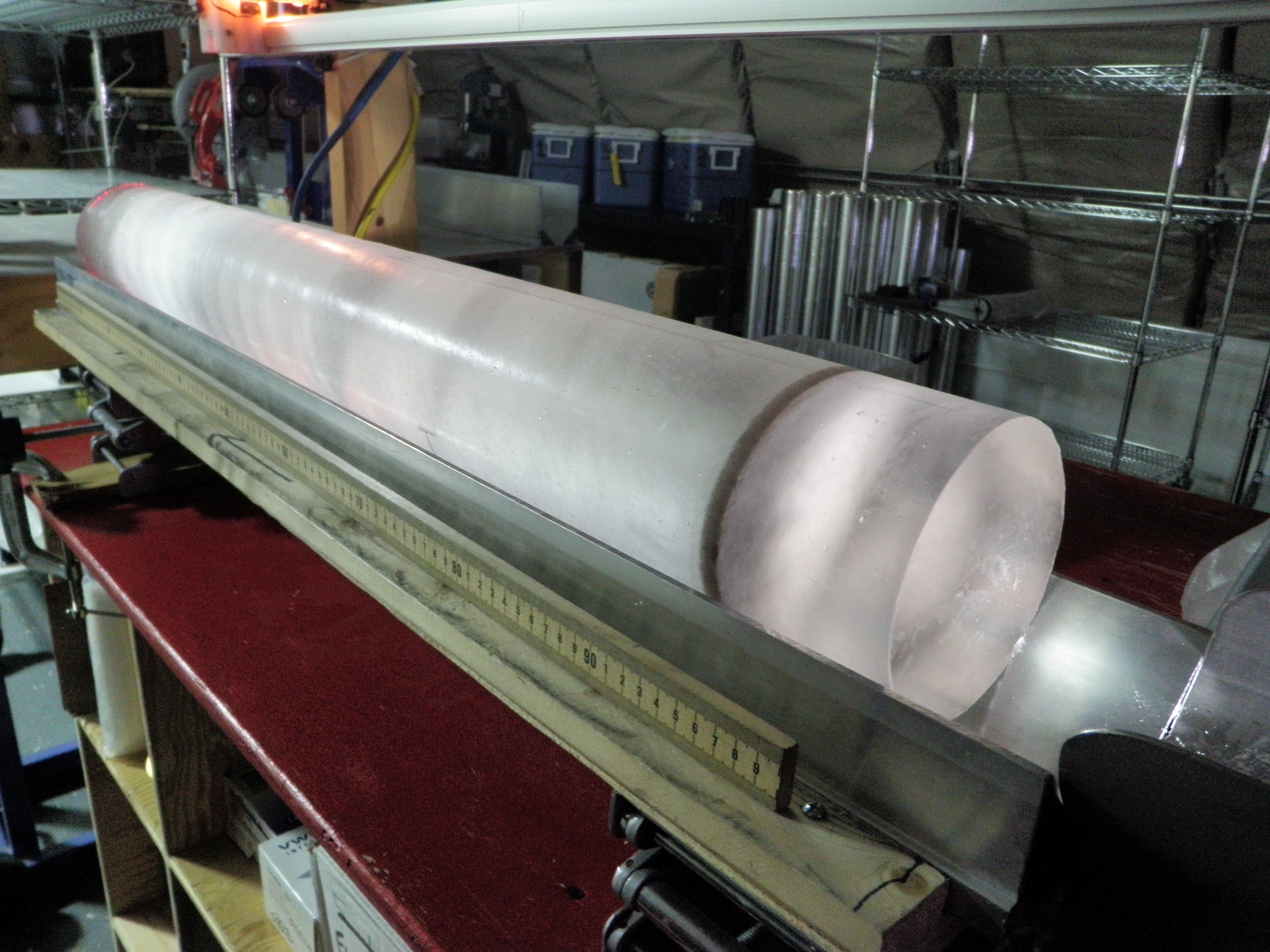
Ice cores are cylinders of ice drilled from ice sheets and glaciers. They are essentially frozen time capsules that allow scientists to reconstruct climate far into the past. Layers in ice cores represent to years and seasons, with the youngest ice at the top and the oldest ice at the bottom of the core. By drilling down into the ice sheet or glacier and recovering ice from aboriginal times, scientists are able to determine the past composition and behavior of the atmosphere, what the climate was similar when the snow fell, and how the size of ice sheets and glaciers have changed in the past in response to dissimilar climate weather. Ice cores have provided climate and ice dynamics data over many hundred thousand years in very high, sometimes seasonal, resolution. This information allows scientists to determine how and why climate changed in the by. Past understanding how and why climate changed in the by, scientists are able to improve predictions of how climate will change in the future.
Because of their high fourth dimension-resolution, the physical nature of their proxy records, and their ability to archive actual greenhouse (and not-greenhouse) gas concentrations from the past, ice cores accept get one of the golden standards in paleoclimate research.
Virtually NSF-ICF
Introduction
The National Scientific discipline Foundation Ice Core Facility (NSF-ICF) — formerly the U.South. National Ice Core Laboratory (NICL) — is a facility for storing, curating, and studying meteoric ice cores recovered from the glaciated regions of the globe. It provides scientists with the capability to bear examinations and measurements on ice cores, and information technology preserves the integrity of these ice cores in a long-term repository for current and future investigations.
Storage & Curation
NSF-ICF's well-nigh of import responsibleness is for the safety and secure storage and curation of ice cores that are collected primarily by National Science Foundation sponsored projects. NSF-ICF currently stores over 17,000 meters of ice cadre collected from various locations in Antarctica, Greenland, and North America. NSF-ICF's main archive freezer is 55,000 cubic feet in size and is held at a temperature of -36°C.
When a shipment of new ice arrives, the insulated boxes carrying the cores are apace unloaded into the main annal freezer. In one case the new ice has come to thermal equilibrium with its new surround, it is advisedly unpacked, organized, racked and inspected. After racking, the tubes are checked into NSF-ICF's inventory system.

Examination & Core Processing
In add-on to the main archive freezer, NSF-ICF also has an examination room held at -25°C that scientists use when examining the ice cores. The examination room is 12,000 cubic feet in size and is contiguous with the chief annal expanse. In addition, there is besides a Class-100 HEPA-filtered, cold clean room held at -25°C that scientists can utilise.
Scientists frequently employ the exam room to cut samples from the ice cores, and then transport the samples dorsum to their academy or laboratory for analysis. Very few analyses on the water ice cores are actually carried-out at the NSF-ICF facility. Almost all of the measurements that are fabricated on the ice cores are conducted back at the scientist'southward university or laboratory.
A frequent activity that is held at NSF-ICF is what is called a cadre processing line, or CPL, for short. When a new ice core arrives at NSF-ICF, researchers from around the country, including young scientists working on their doctorates, gather at NSF-ICF for the CPL. During the CPL, the scientists—along with NSF-ICF staff—measure, catalog, cut and ship pieces of the ice core to their respective universities and laboratories for analysis. Depending on the complexity of the cut program, cores tin typically exist run through a CPL at a rate of 30-35 meters per day. At this rate, a 1000-meter long ice core takes half dozen to eight weeks to process.
The floor plan of the exam room will be specifically tailored to the number of scientists and the type of science or sampling which volition exist done during a particular CPL. As many as x different preparation, cutting, or analysis stations may be prepare to conform the core with additional processing being performed off the main line if required.
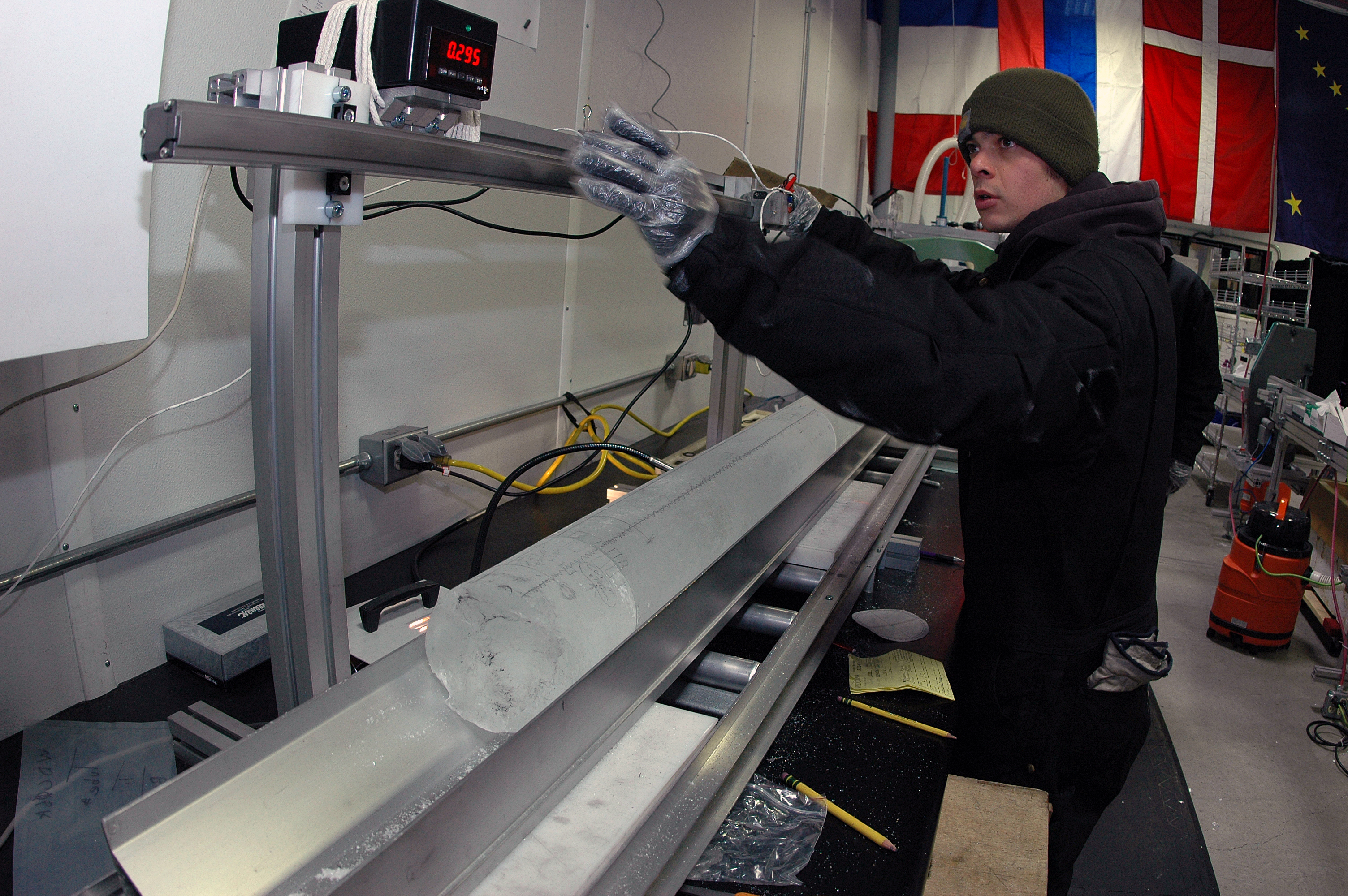
Drilling Water ice Cores
Introduction
Ice cores are drilled in glaciers and on ice sheets on all of Earth's continents. Most water ice cores, withal, come from Antarctica and Greenland, where the longest ice cores extend to 3 kilometers—over 2 miles—or more in depth. Water ice cores from the cold interior regions of polar ice sheets provide exceptionally well-preserved and detailed climate records. This is because the lack of melt at these locations does non decadent the record of trapped gases or blur the record of other impurities. The oldest continuous ice core records extend to 130,000 years in Greenland, and 800,000 years in Antarctica.
Ice cores are typically drilled by ways of either a mechanical or thermal drill. Both types of drills incise an annulus, or circle, around a primal, vertical core.
A mechanical drill is simply a rotating pipage, or drill barrel, with cutters at the head. When the drill barrel is rotated, the cutters incise a circle around the water ice to be cored until the barrel is filled with ice. The cuttings—besides referred to every bit chips—are transported to a chip chamber in the drill. The drill barrel is rotated past either physical force, as in the case with simple manus augers, or with an electromechanical motor drive, as in the case with sophisticated electromechanical drills. Thermal drills, in dissimilarity, use a ring-shaped heating element to melt an annulus around the water ice to be cored and the melt water is stored in a tank in the drill.
At sites where the ice is well below freezing, such as the interiors of the polar water ice sheets, mechanical drills must be used. In contrast, thermal drills are particularly effective at coring through warmer ice (due east.grand., ice approximately above -x°C) and are frequently used on mid- or depression-latitude glaciers. On many non-polar glaciers, however, water ice conditions tin can vary from "common cold" ice to "warm" ice, requiring both mechanical and thermal drilling to recall the best possible core quality over the entire depth interval that is drilled.
The length of the drill butt determines the maximum length of a core section that can exist retrieved in a unmarried drill run. Ice cores are typically retrieved in sections that are ane meter to as much every bit half-dozen meters in length, and typically 50-132 millimeters in diameter. The collection of a long ice cadre therefore requires many repeated cycles—or drill runs—of lowering the drill, cutting a cadre section, raising the drill back to the surface, removing the drilled water ice core department from the barrel, and readying the drill to go back downwardly the hole to call back more ice.

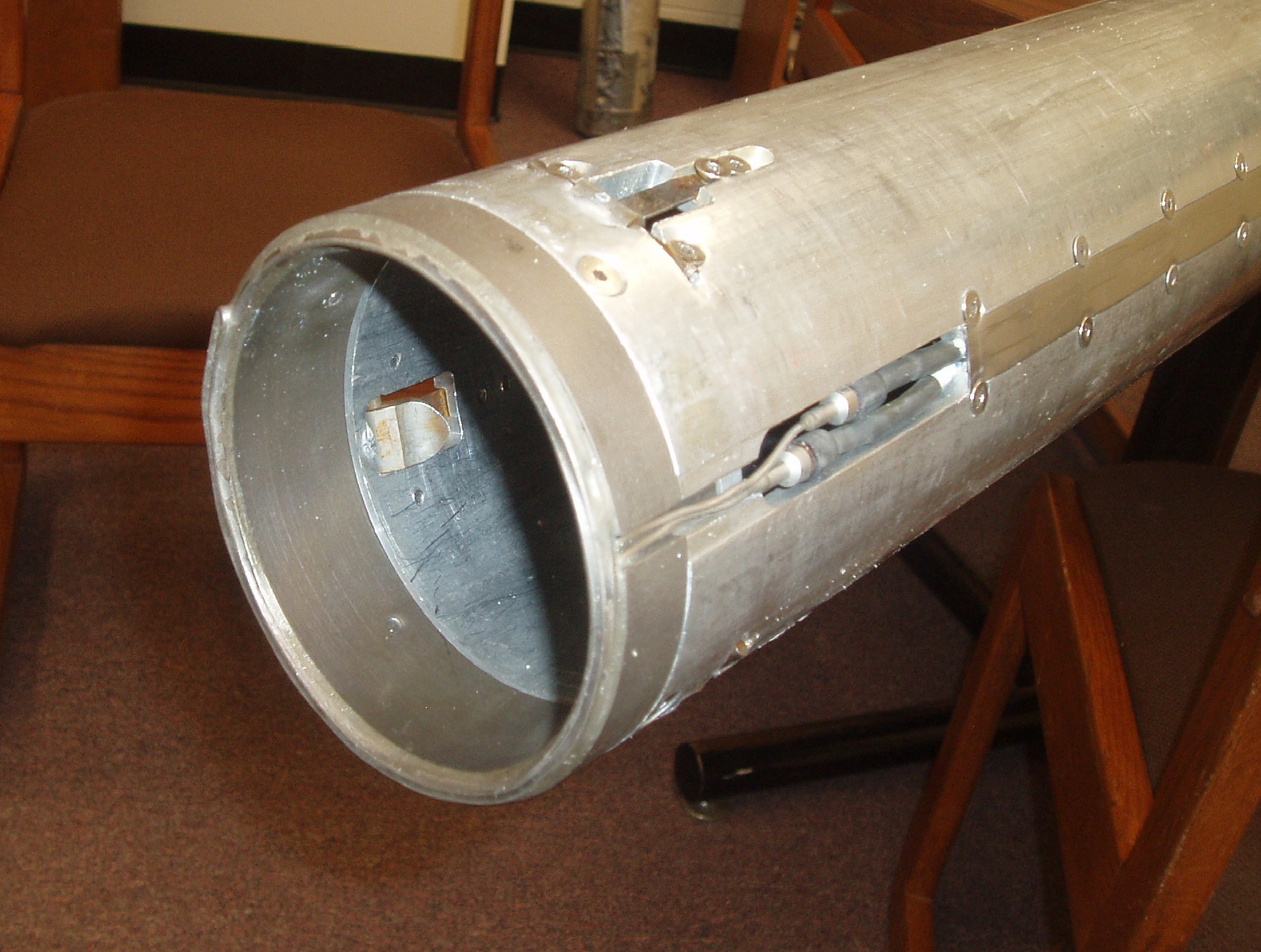
Hand Augers
When scientists are interested in collecting water ice cores from the top 20- to 30-meters of a glacier or ice canvass a hand auger is commonly used. In the United States, at that place are four types of hand augers commonly used: the SIPRE auger, the PICO auger, the Kovacs auger, and the IDDO auger.
The hand auger is the nearly bones of the mechanical drills and consists of a butt and cutting caput. The butt is typically i meter long and with an internal diameter of either 3 or 4 inches. A protruding thread spiraling up and effectually the barrel is used to remove the ice fries from the cutting confront. The cutter head includes two or 3 hardened steel or carbide teeth, and the protrusion of the teeth can be adjusted to command the depth of cut. If the depth of cut is set too pocket-size, the cutter head will skid over the ice surface rather than cut downward into information technology. If the depth of cutting is set too large, the teeth will become lodged in the ice halting the drilling altogether.
The hand auger is driven from the surface by a series of extensions that are added as drilling proceeds into the ice. The hand auger, like all other coring drills, has to be retrieved each time a core department is recovered. Hand augers are either driven by manus, using an attached T-bar, or adapted to use a powered motor drive or drill. The maximum depth to which a hand auger and its extensions tin be raised and lowered in and out of a borehole past ii people is ~20-30 meters. A mechanical winch/lifting system is generally required at greater depths. The depth limit for hand augers is express by the forcefulness and flexibility of the extension rods to ~40 meters.
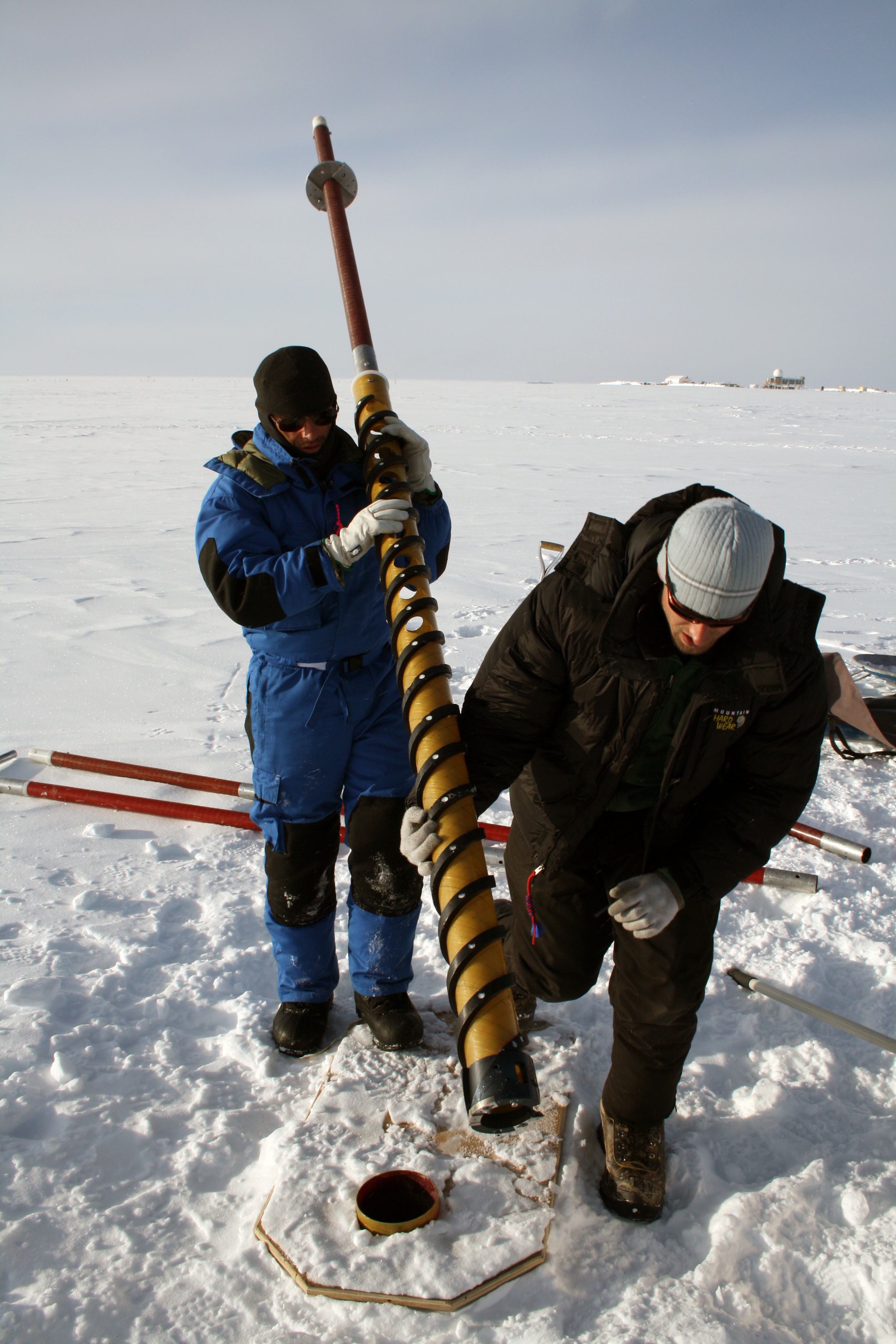
Shallow Ice Coring
When depths greater than ~xl meters demand to be reached, ice coring projects typically use specialized electromechanical or electrothermal drills that hang on a cable. The cable runs from a winch over a top wheel—called a sheave—on a vertical tower. The cable has electrical wires inside that ability the drill and allow for operation of the drill from the surface. This type of drilling is referred to as cablevision-suspended drilling, and is the preferred drilling method when drilling intermediate and deep ice cores. While several early ice drilling projects used conventional surface-driven rotary and wireline drill rigs to collect ice cores, the employ of specialized cable-suspended drills to collect ice cores is now the common practice. Cable-suspended drill systems are preferred because they significantly decrease the weight of the drill and its ability consumption, shorten the time of travel in and out of the borehole, and simplify the process of removing the cuttings from the borehole.
While almost cable-suspended drills are similar in design, the details practise vary from drill to drill, often with specific projects and field sites in heed. For instance, due to the remoteness and high-altitude of most non-polar glaciers, the drills used at these locations must be lightweight and of modular pattern to permit for transportation past helicopter, or for glaciers located above the range of helicopter functioning (east.chiliad., to a higher place 5500 meters pinnacle), transportation by either porters or pack animals. In the polar regions, extremely low temperatures and very remote and logistically complicated field sites influence the design of the drills used.
Below are general descriptions for two types of cable-suspended ice coring drills: electromechanical and electrothermal. More detailed information can be constitute by reading the literature noted in References and Links.
Cable-Suspended Electromechanical Drills
There are many versions of the electromechanical (EM) drill used in ice coring. The portion of the drill that goes down the borehole is chosen the sonde, and its just physical connexion to the surface is through its suspending cablevision. The components of the sonde typically include a cutting head that is fastened to an inner butt, an outer barrel, a motor to rotate the inner barrel, and an anti-torque arrangement that counteracts the rotational cut action.
The cutting caput typically has 3 to 4 hardened steel or carbide teeth that shave ice in an annulus effectually the cardinal, vertical core. The protrusion of the teeth and their subsequent depth of cutting into the ice are controlled with small, adaptable buttons chosen shoes that are located on the lesser face of the cutter head. The vertical distance between the bottom of the shoes and the cutters determines the depth of cutting into the ice.
A protruding thread, likewise referred to as flights, spiraling upward and around the inner barrel is used to remove the ice chips from the cutting confront. As the cutting head spins around and the cutters shave the ice, the chips are transported upwards the flights betwixt the ii barrel sections. The inner barrel spins while the outer barrel stays stationary, and it is that difference that really drives the chips upward along the flights to the superlative of the sonde thus removing them from the cutting face.
Most cablevision-suspended EM drills are designed as double-barreled (e.g., an inner butt and an outer barrel) for several reasons. Double-barreled drills collect ice chips more efficiently than unmarried-barreled drills, and the added stiffness of the double-barreled blueprint typically results in fewer breaks in the cores that are drilled, as well as straighter boreholes.
Because of the slap-up depths that can exist reached, cable-suspended EM drills are often used with a drilling fluid to prevent closure of the borehole at depth (see Deep Ice Coring).
The anti-torque organization on EM drills often consists of iii or four leaf springs that anchor the sonde to the wall of the borehole. If there is no anti-torque department, the motor will crusade the entire EM drill and cable to rotate inside the borehole, preventing the ice from being cut and causing the cablevision to become wrapped.
When a drill run is finished and the butt is full with ice, the core is typically held in the inner butt by spring-loaded lever arms called core dogs that grip, break, and retain the ice core when the cablevision and sonde is pulled upward. The sonde is then hoisted to the surface with the winch and the core removed. In many modern cablevision-suspended EM drill systems, the sonde and belfry both tilt from the vertical position to the horizontal position to assist in the removal of the ice core and the chips.
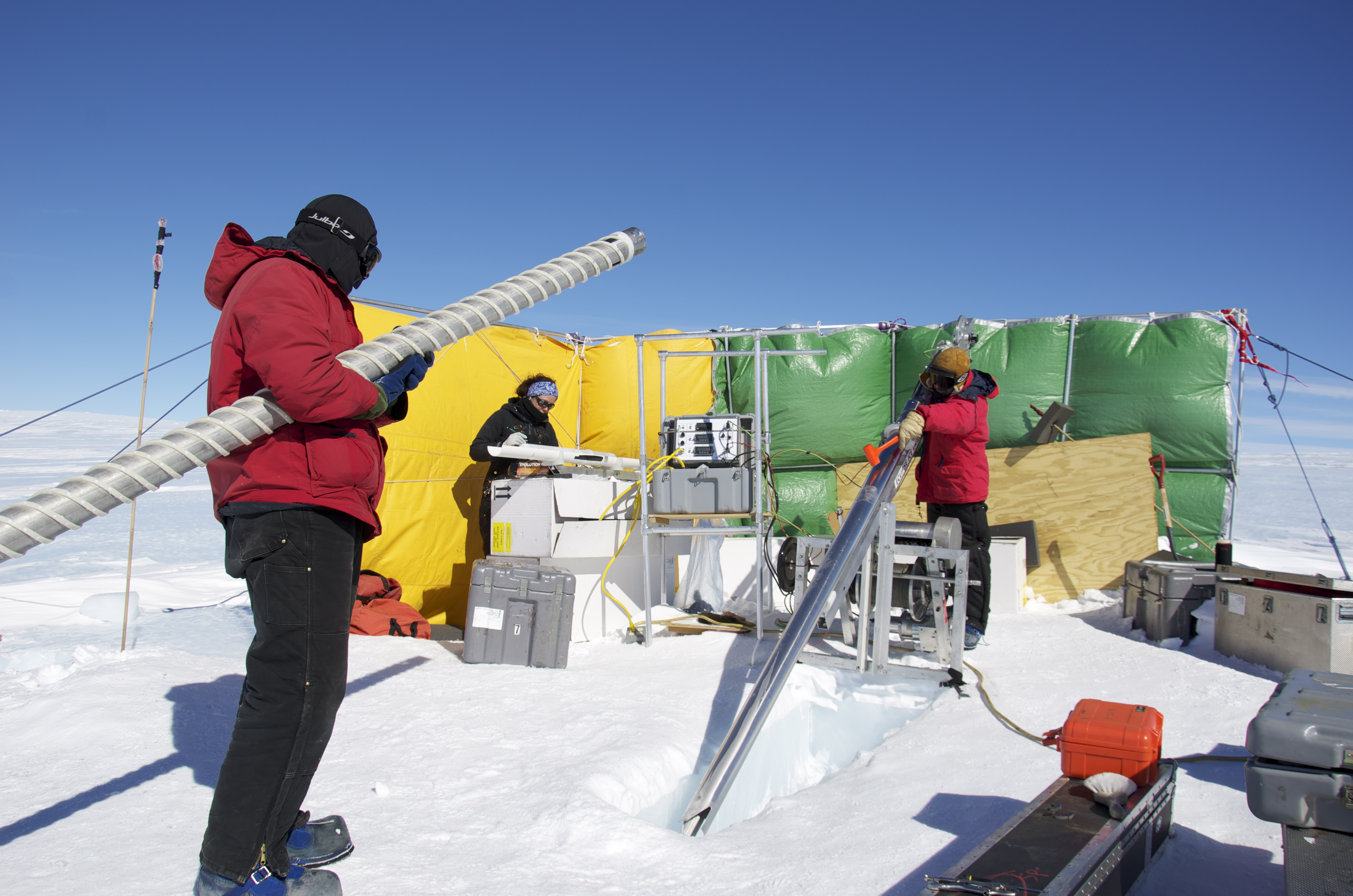
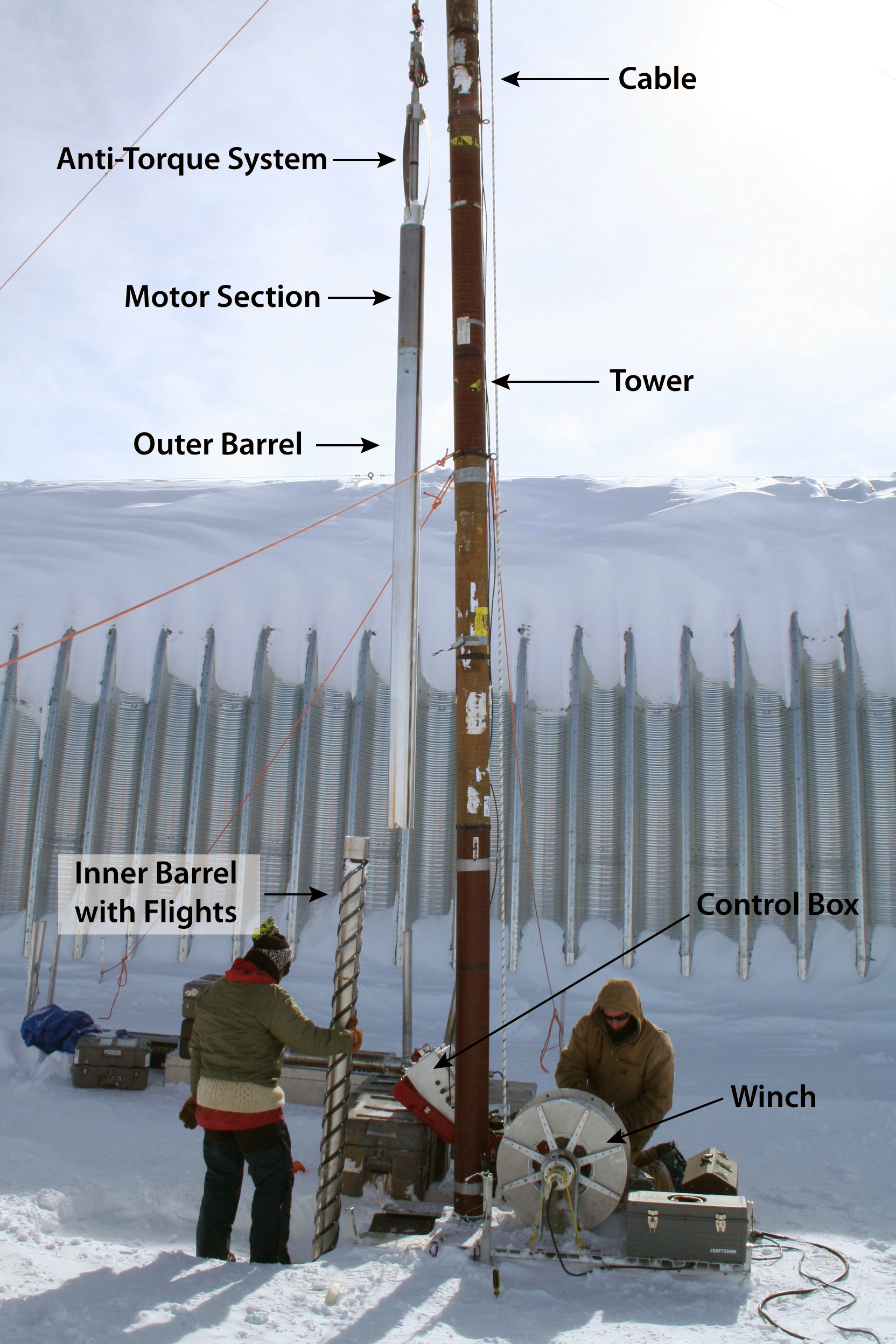
Cablevision-Suspended Electrothermal Drills
The electrothermal (ET) drill uses a band-shaped heating chemical element in the coring head to melt an annulus around the water ice to be cored, rather than shaving it away with cutters like the EM drill. The electrical power to estrus the coring caput is fed through the drill'south suspending cable.
The meltwater that is produced by ET drills may either be left downwards the hole or stored in a tank within the sonde. When englacial temperatures are low and at that place is concern that the meltwater may re-freeze causing the borehole to close-in on itself, the meltwater is either stored in a tank in the sonde and emptied once on the surface, or the meltwater is mixed with an antifreeze solution and left downwards the hole. For depths below which borehole closure in an open hole is a concern, the meltwater is left down the pigsty to help prevent hole closure. If re-freezing is also a concern, the meltwater that is left down the pigsty is mixed with an antifreeze solution.
ET drills have simply one barrel, so the size of the borehole is by and large smaller than a borehole from an EM drill for a similar diameter ice core. ET drills are mechanically much simpler than EM drills because they contain fewer moving parts. They also exercise not require an anti-torque system since there is no rotational cutting action. ET drills are also generally more than compact in size and weight than EM drills, in part because no chip storage is required.
While ET drills are especially effective at coring through warmer water ice (e.g., ice approximately above -x°C) they have likewise been used to drill in cold water ice in Antarctica. The chief disadvantage of using ET drills to drill cold water ice (e.g., water ice approximately below -xv°C) is the large thermal stupor that occurs to the core, which is bad for many types of measurements that are typically made on ice cores.
Deep Ice Coring
For depths below which borehole closure in an open hole is a concern, a drilling fluid is used to brand sure that the pressure in the borehole is approximately the same as the surrounding ice to preclude closure of the borehole. The plastic nature of water ice, which is what produces the pigsty closure, is strongly temperature dependent and therefore the depth at which a drilling fluid is required to foreclose borehole closure is also strongly temperature dependent. A drilling fluid may be required equally early every bit 100 meters depth on glaciers that are at their melting point (e.m., temperate glaciers), or as deep equally 1000 meters on the high, extremely-cold interior plateau of Eastward Antarctica. In general, drilling fluids are used whenever depths greater than ~300 meters are required.
Deep ice cadre drilling, that is, to depths where the utilize of a drilling fluid is required, is typically carried-out using cable-suspended EM drills that utilize a pump to circulate both the drilling fluid and the chips through screens that separate the fries from the fluid.
The deepest water ice core records come from Antarctica and Greenland, where the very deepest water ice cores extend to 3 kilometers (over 2 miles) in depth. The oldest continuous water ice core records extend to 130,000 years in Greenland, and 800,000 years in Antarctica. The United States (U.S.), Denmark, Russian federation, French republic, Frg and Japan have all adult highly specialized cable-suspended EM drills for the purpose of recovering ice cores to depths of ii kilometers or more.
The most recent U.South. deep water ice coring project is the West Antarctic Ice Canvas Divide (WAIS Split) projection in West Antarctica, funded by the National Science Foundation. Afterward seven field seasons of preparation and drilling, the WAIS Dissever project reached its concluding depth goal of 3,405 meters on Dec 31, 2011, completing the longest U.South. ice core always recovered from the polar regions.
The WAIS Divide ice cadre was drilled using the U.South. Deep Ice Sheet Coring Drill (DISC Drill). The DISC Drill is a cablevision-suspended EM drill system capable of cutting and retrieving cores of water ice—in 3 meter long sections—to depths of ~4,000 meters. The sonde consists of a cutter head, a core barrel in which the core is collected, screens to remove chips from the drill fluid, a motor and transmission to bulldoze the cutter head, a pump to circulate water ice cuttings in the drill fluid through the sonde, an instrumentation/control section, an anti-torque section to stabilize the drill in the borehole, and the mechanical, electrical power, and cobweb optic terminations of the cable. The 15 mm diameter cable suspends the drill sonde in the borehole and also provides electrical power and fiber optic communication to the sonde. The drill's cutter caput contains four razor-precipitous cutters that shave out an annulus of ice, which the 14 meter long sonde slides down into. Every bit the sonde slides downwardly into the annulus information technology slides over the core, which is 12.2 centimeters in diameter. When a cable pulls upward the sonde, iv cams take hold of the core and fracture it. After the sonde is pulled back to the surface, the sonde and belfry are tilted as ane unit from a vertical to a horizontal orientation and the cadre is pushed out.
The iii,405 meter long core was drilled over the form of half-dozen field seasons. Typically, ~40 days were available each season for drilling, and drilling operations were conducted on a 24-hours per twenty-four hour period, vi-days per week schedule by a crew of ~9 drillers (iii shifts of iii drillers/shift) each flavor.
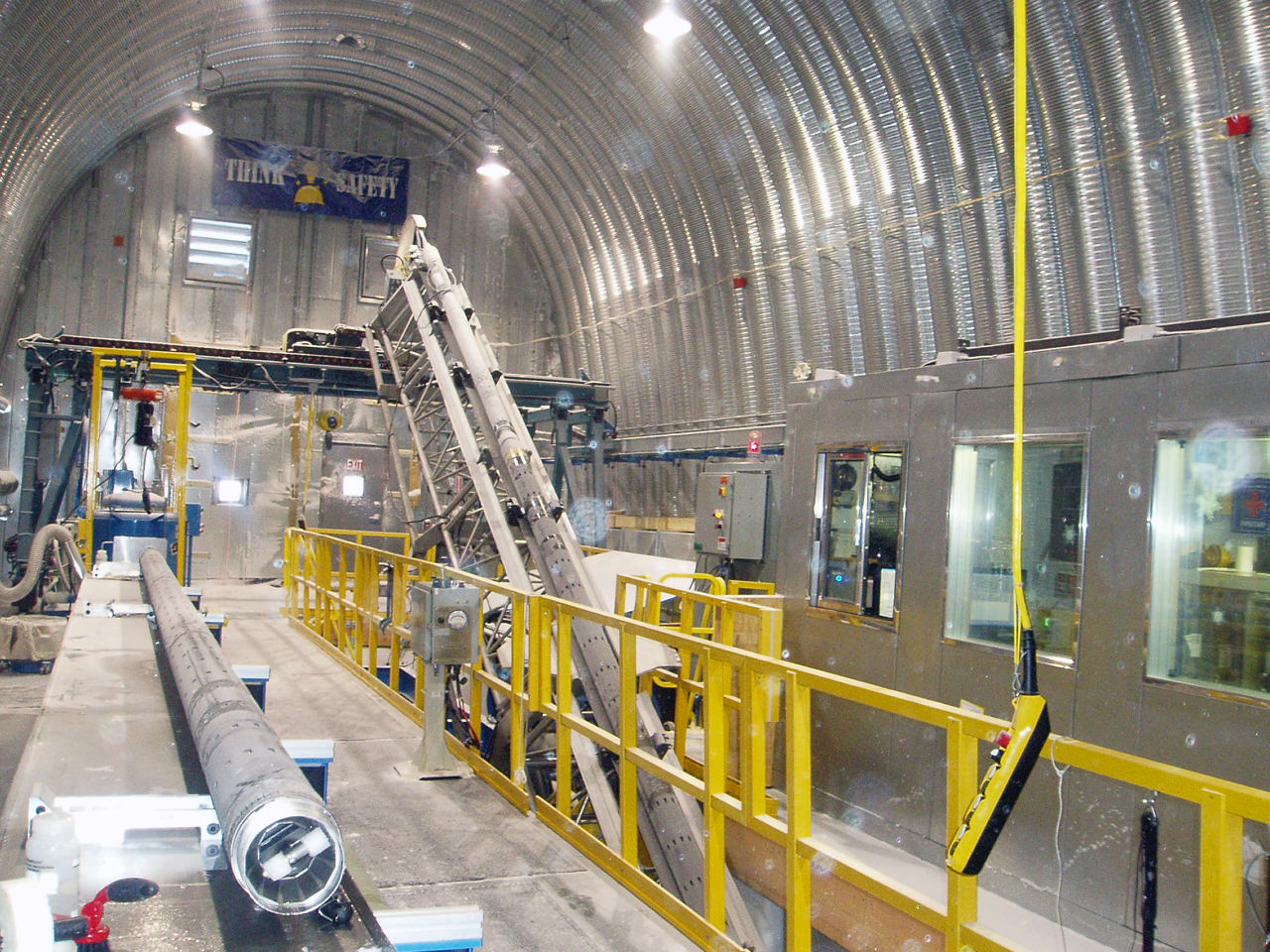

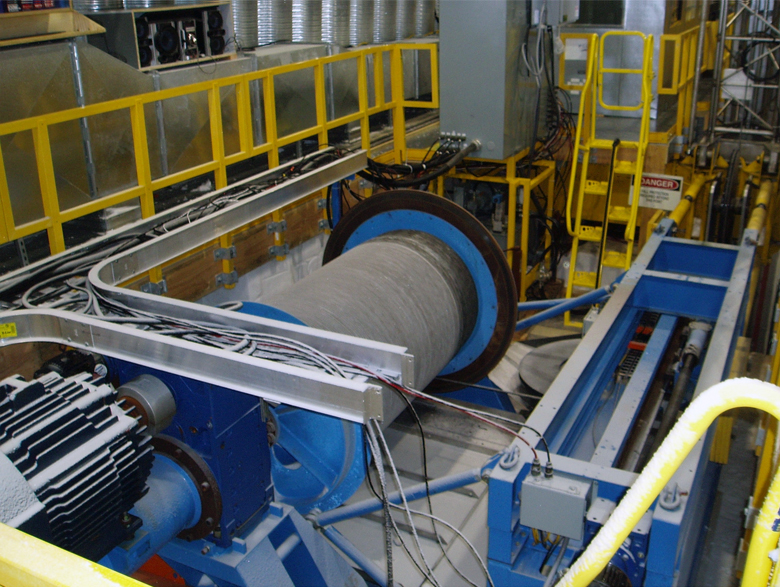
Source: https://icecores.org/about-ice-cores
0 Response to "How Do Yec's Explain Ice Core Readings"
Post a Comment